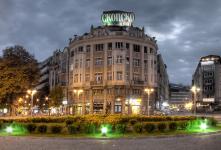 The size and cost of the Alexander the Great statue planned for Skopje’s central square, as well as the lack of transparency on the part of the authorities over its commissioning, has provoked a series of attacks on the proposal.
The size and cost of the Alexander the Great statue planned for Skopje’s central square, as well as the lack of transparency on the part of the authorities over its commissioning, has provoked a series of attacks on the proposal.
Art critics, sculptors and architects alike argue that the grandiose monument of the ancient warrior king is too big for its surroundings at 22metres tall, and is more akin to the monoliths previously put up by authoritarian regimes.
“I wonder why a monument of this size? Maybe for the Greeks in Athens to see that we too have an Alexander of our own,” well-known sculptor Blagoja Cuskov told the Utrinski Vesnik daily.
He argues that such a lavish monument – as tall as an eight-storey building – would overshadow the surrounding city square.
The architect Miroslav Grcev says statues of this size are a characteristic of authoritarian regimes. “Saddam Husein was the last who built a giant monument,” Grcev said.
He and others have noted that the public does not know how this sculpture and another nine bronze statues, costing a total 10 million euro, were commissioned.
Grcev said that the artist behind the Alexander statue, which will cost 4.5 million euro, is relatively unknown. The public first heard about Valentina Stevanovska last year where she was chosen to make the monument of Alexander’s father, Phillip of Macedon, in one municipality in the outskirts of Skopje. It is not clear how she was chosen or who chose her.
Rumours about the statues have swirled in the past few months. But details of the form, size and commissioning were only released earlier this week after the Dnevnik newspaper published documents it had received about their construction.
Following the publication of the article, the mayor of Skopje’s central municipality was forced to disclose details about the statues.
But while he confirmed that the central government will pay for them, the ministry of culture has since remained silent.
The statue of Alexander the Great is scheduled to be erected by the end of next year.
Some commentators say that the sheer number of monuments that are currently being planned, without any prior public debate or quality control, can potentially harm the city’s public space.
 Eurasia Press & News
Eurasia Press & News



